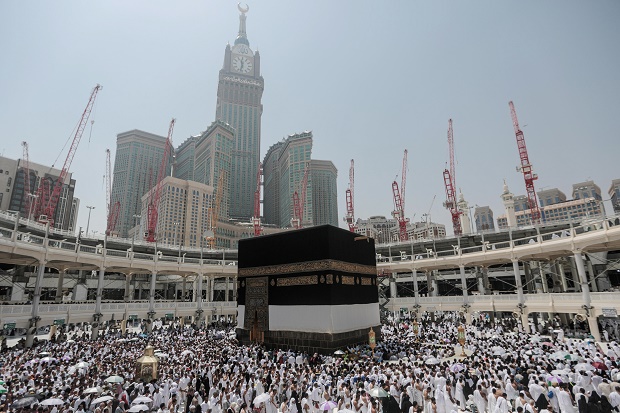
Muslim pilgrims circle the Kaaba, the cubic building at the Grand Mosque in the Muslim holy city of Mecca, Saudi Arabia, Tuesday, Sept. 22, 2015. In Mecca, the holy site all the worlds Muslims pray toward, the annual hajj pilgrimage began Tuesday with over 2 million faithful gathering to call out in Arabic: “Here I am, God, answering your call. Here I am.” AP Photo
MUZDALIFAH, Saudi Arabia—A sea of Muslim pilgrims moved on Wednesday towards the holy site of Muzdalifah in Saudi Arabia, where they gather pebbles for the last major rite of this year’s hajj.
Their symbolic stoning of the devil on Thursday will coincide with the Eid al-Adha feast of sacrifice marked by the world’s more than 1.5 billion Muslims.
Around two million white-clad faithful spent a day of prayer Wednesday on a vast Saudi plain and its Mount Arafat for the peak of the hajj pilgrimage.
READ: At the hajj, biscuits for some, buffets for others
Police sirens pierced the air and helicopters hovered overhead as the faithful later arrived at nearby Muzdalifah, where water sprays cooled them. They placed prayer rugs and mats on the ground where they will remain until dawn. Many laid down to rest but others savored tea and refreshments offered by fellow pilgrims.
Most were busy choosing the pebbles they planned to use for the next day’s stoning, storing them in empty water bottles.
“We are implementing the prophet’s sunnah (tradition)” by gathering the stones, said Mezian Abdelkarim, 60, of Algeria.
“We pick up a total of 49 pebbles to stone the devil,” said Bangladeshi pilgrim Shafiq al-Alim, who is performing the pilgrimage for his dead grandmother.
He and others had earlier prayed and recited the Koran at Mount Arafat, a 300-meter-high (328 yards) slippery, rocky hill where they believe the Prophet Mohammed gave his last sermon 14 centuries ago after leading his followers on hajj.
Carrying colorful umbrellas as protection from the searing heat, they had walked from dawn in massive crowds towards the plain and its hill—also known as Mount Mercy.
“We prayed as much as we could, with much spirituality,” said Mohammed Zahran, 39, of Lebanon.
Unlike in previous years, only a few pilgrims were seen carrying their countries’ flags, in what Saudi media said was a “ban” during the pilgrimage.
The kingdom’s authorities have repeatedly warned against the use of political slogans or banners during hajj.
Saudi Arabia’s civil defense agency reported more than 200 cases of “fainting and fatigue” after doors failed to operate and crowds formed at a station of the Mashair Railway, which moves pilgrims between the holy sites.
The faithful gathered in their hundreds of thousands for noon prayers at Mount Arafat, where Saudi Arabia’s top cleric, Grand Mufti Sheikh Abdulaziz al-Shaikh, gave his annual sermon.
He used the opportunity to attack Yemen’s Iran-backed rebels, against whom the kingdom has been leading a military coalition since March. The Huthi rebels at war with Saudi and Gulf troops in Yemen are “a group of criminals,” Shaikh charged.
Most Yemeni pilgrims performing the hajj this year already reside in the kingdom.
After Muzdalifah, some pilgrims head to Mecca to circumambulate the cube-shaped holy Kaaba structure while others go to Mina—a tent city which will be the final stop for pilgrims and where the stoning ritual occurs.
It emulates the Prophet Abraham, who is said to have stoned the devil at three locations when he tried to dissuade Abraham from God’s order to sacrifice his son Ishmael.
Unity of pilgrims
Almost 1.4 million foreign pilgrims are joining hundreds of thousands of Saudis and residents of the kingdom for this year’s hajj.
READ: Crane collapse kills 107 at Mecca’s Grand Mosque ahead of hajj
They are undeterred by a construction crane collapse at Mecca’s Grand Mosque, Islam’s holiest site, that killed 109 people including foreign pilgrims earlier this month.
About 400 people were injured by the crane which was working on an expansion of the mosque.
Previously marred by stampedes and fires that killed hundreds, the pilgrimage had been largely incident-free for the past nine years after safety improvements.
The hajj is among the five pillars of Islam and every capable Muslim must perform it at least once in a lifetime.
For many, it is the spiritual peak of their lives.
READ: Saudi MERS infections soar ahead of hajj pilgrimage
This year’s gathering takes place against a backdrop of increased jihadist violence in some Muslim countries, a surge of the potentially deadly MERS virus, as well as the war in Saudi Arabia’s neighbor Yemen.
Authorities say they are on alert for possible attacks by extremists, after Islamic State group jihadists bombed security forces and Shiite mosques in the kingdom in recent months.
Potential transmission of the Middle East Respiratory Syndrome coronavirus (MERS-CoV) is another challenge facing authorities but health officials say there has never been a case of MERS infection among pilgrims.
Hajj began on Tuesday when pilgrims entered ihram, a state of purity in which they must not quarrel, wear perfume, or cut their nails or hair.
During ihram, men wear a seamless two-piece shroud-like white garment, while women must wear loose dresses, generally also white, exposing only their faces and hands.
The clothing emphasizes the unity of pilgrims, regardless of their nationality or whether they stay in one of Mecca’s five-star hotels or a shabby high-rise hostel.